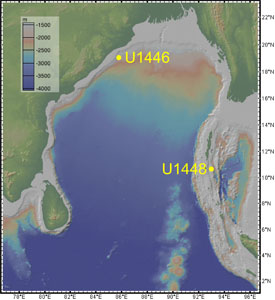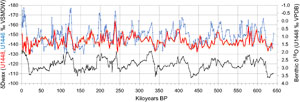Clemens, S.C., Kuhnt, W., LeVay, L.J., and the Expedition 353 Scientists
Proceedings of the International Ocean Discovery Program Volume 353
publications.iodp.org
https://doi.org/10.14379/iodp.proc.353.204.2025
Data report: Site U1448 leaf wax hydrogen isotopes, IODP Expedition 353, Andaman Sea1
S.M. McGrath,2 S.C. Clemens,2 and Y. Huang2
1 McGrath, S.M., Clemens, S.C., and Huang, Y., 2025. Data report: Site U1448 leaf wax hydrogen isotopes, IODP Expedition 353, Andaman Sea. In Clemens, S.C., Kuhnt, W., LeVay, L.J., and the Expedition 353 Scientists, Indian Monsoon Rainfall. Proceedings of the International Ocean Discovery Program, 353: College Station, TX (International Ocean Discovery Program). https://doi.org/10.14379/iodp.proc.353.204.2025
2 Department of Earth, Environmental, and Planetary Sciences, Brown University, USA. Correspondence author: steven_clemens@brown.edu
Abstract
This data report presents the leaf wax hydrogen isotopic record from International Ocean Discovery Program Site U1448 in the Andaman Sea. The record includes 270 analyses spanning from the core top to 39.24 m core composite depth below the seafloor. This depth interval spans the past 638 ky with an average temporal resolution of ~2.37 ky (14 cm sample interval). Site U1448 has a published benthic isotope chronostratigraphy as well as previously published paired leaf wax carbon isotope data, enabling a better understanding of hydroclimate in the Andaman region.
1. Introduction
Site U1448 (Figure F1) is located on top of a rise at 1091 meters below sea level (mbsl), ~44 km offshore Little Andaman Island (Clemens et al., 2016b). The interval cored reached 420.6 m core depth below seafloor, Method A (CSF-A) (Clemens et al., 2016a). The recovered sediments include the Miocene to recent time interval and can be used to reconstruct changes in regional monsoon circulation and ocean circulation at tectonic to suborbital timescales. Here, we present the late Pleistocene leaf wax hydrogen isotope (δDwax) record at orbital-scale resolution.
The Site U1448 δDwax data herein, along with the paired leaf wax δ13C record (McGrath et al., 2023) will allow the reconstruction of changes in rainfall isotopic composition over the past 638 ky, providing insight into the moisture source areas and transport path dynamics of convective rainfall in the Andaman region; the Site U1448 age model is found in Clemens (2022). These Site U1448 data, combined with published Site U1446 leaf wax isotope records from the northeast Indian margin (McGrath et al., 2021), yield a southeast–northwest Bay of Bengal transect. Combined, these data will allow for the calculation of rainfall isotope gradients across the Bay of Bengal at the glacial–interglacial and orbital scales based on records that include moisture transport dominated by cross-continent (Site U1446) and oceanic (Site U1448) paths.
2. Methods and materials
Lipids from 270 samples were extracted from 3 to 8 g of dry sediment with an Accelerated Solvent Extractor 200 (Dionex) using dichloromethane (DCM):methanol 9:1 (v:v). The extracts were dried under N2 and separated on aminopropyl silica gel flash columns, eluting neutral fractions with DCM:isopropanol 2:1 (v:v) and acid fractions with 4% acetic acid in diethyl ether. All flash column separations used three column volumes of each eluent. Acid fractions were methylated in anhydrous 5% HCl in methanol at 60°C overnight. Samples were further cleaned using silica gel flash columns: nonpolar compounds were removed with hexane, and fatty acid methyl esters (FAMEs; our target compounds) were eluted with DCM. The δD of the C28 n-alkanoic acid were measured using gas chromatography–pyrolysis isotope ratio mass spectrometry at Brown University (USA). Samples were run in triplicate. The pooled standard deviation of triplicate samples is 1.8‰, and the standard deviation of a standard run every three injections is 2.5‰.
3. Results
Site U1448 δDwax values (Figure F2; Table T1) span −163‰ to −129‰ with a mean of −143‰ Vienna standard mean ocean water (VSMOW). Visual comparison to Site U1448 benthic δ18O indicates glacial–interglacial cyclicity is present, with smaller (depleted) values during interglacial intervals. The most depleted values during interglacial intervals reach approximately −155‰, and the largest (most enriched) glacial-age values reach approximately −135‰. Interglacial δD minima in the Andaman record are not as extreme as those at the Indian margin, but the glacial age maxima are similar at the two sites.
4. Acknowledgments
The International Ocean Discovery Program (IODP) provided samples for this work under Sample Request 017275-IODP. The analyses were funded by the United States National Science Foundation.
References
Clemens, S., 2022. Data report: Site U1448 Pleistocene benthic foraminiferal stable isotopes, Andaman Sea, IODP Expedition 353. In Clemens, S.C., Kuhnt, W., LeVay, L.J., and the Expedition 353 Scientists, Indian Monsoon Rainfall. Proceedings of the International Ocean Discovery Program, 353: College Station, TX (International Ocean Discovery Program). >https://doi.org/10.14379/iodp.proc.353.203.2022
Clemens, S.C., Kuhnt, W., LeVay, L.J., Anand, P., Ando, T., Bartol, M., Bolton, C.T., Ding, X., Gariboldi, K., Giosan, L., Hathorne, E.C., Huang, Y., Jaiswal, P., Kim, S., Kirkpatrick, J.B., Littler, K., Marino, G., Martinez, P., Naik, D., Peketi, A., Phillips, S.C., Robinson, M.M., Romero, O.E., Sagar, N., Taladay, K.B., Taylor, S.N., Thirumalai, K., Uramoto, G., Usui, Y., Wang, J., Yamamoto, M., and Zhou, L., 2016a. Expedition 353 methods. In Clemens, S.C., Kuhnt, W., LeVay, L.J., and the Expedition 353 Scientists, Indian Monsoon Rainfall. Proceedings of the International Ocean Discovery Program, 353: College Station, TX (International Ocean Discovery Program). >https://doi.org/10.14379/iodp.proc.353.102.2016
Clemens, S.C., Kuhnt, W., LeVay, L.J., Anand, P., Ando, T., Bartol, M., Bolton, C.T., Ding, X., Gariboldi, K., Giosan, L., Hathorne, E.C., Huang, Y., Jaiswal, P., Kim, S., Kirkpatrick, J.B., Littler, K., Marino, G., Martinez, P., Naik, D., Peketi, A., Phillips, S.C., Robinson, M.M., Romero, O.E., Sagar, N., Taladay, K.B., Taylor, S.N., Thirumalai, K., Uramoto, G., Usui, Y., Wang, J., Yamamoto, M., and Zhou, L., 2016b. Site U1448. In Clemens, S.C., Kuhnt, W., LeVay, L.J., and the Expedition 353 Scientists, Indian Monsoon Rainfall. Proceedings of the International Ocean Discovery Program, 353: College Station, TX (International Ocean Discovery Program). >https://doi.org/10.14379/iodp.proc.353.108.2016
McGrath, S.M., Clemens, S.C., and Huang, Y., 2023. Pleistocene Sunda Shelf submersion-exposure cycles initiate vegetation Walker Circulation feedback. Geology, 51(11):1053–1056. >https://doi.org/10.1130/G51412.1
McGrath, S.M., Clemens, S.C., Huang, Y., and Yamamoto, M., 2021. Greenhouse gas and ice volume drive Pleistocene Indian Summer Monsoon precipitation isotope variability. Geophysical Research Letters, 48(4):e2020GL092249. >https://doi.org/10.1029/2020GL092249
Ryan, W.B.F., Carbotte, S.M., Coplan, J.O., O'Hara, S., Melkonian, A., Arko, R., Weissel, R.A., Ferrini, V., Goodwillie, A., Nitsche, F., Bonczkowski, J., and Zemsky, R., 2009. Global multi-resolution topography synthesis. Geochemistry, Geophysics, Geosystems, 10(3):Q03014. >https://doi.org/10.1029/2008GC002332

